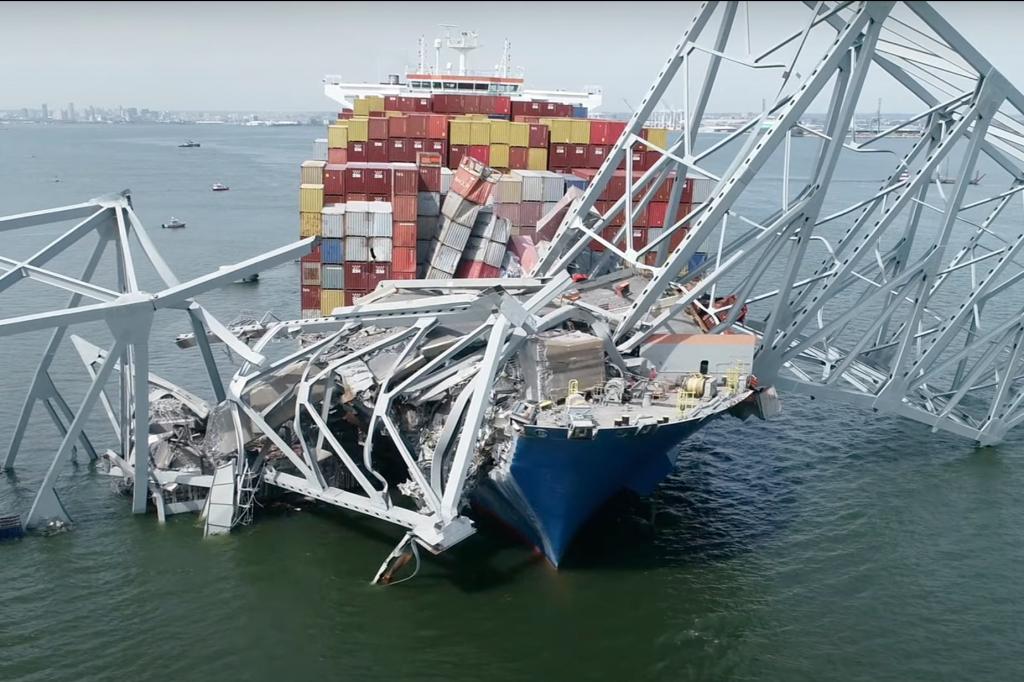‘Miracle’ tales of survival emerge from workers who were on break in cars when Baltimore bridge collapsed: ‘I’m going to die here’
Contact The Author
The wife of one of the construction workers who survived the collapse of a Baltimore bridge said they were on a break when tragedy struck — and that it’s a “miracle” that her husband survived because he can’t swim.
“All of the men were on a break in their cars when the boat hit. We don’t know if they were warned before the impact,” the wife of Julio Cervantes told NBC News on Thursday.
“My husband doesn’t know how to swim. It is a miracle he survived,” added the relieved wife, who didn’t disclose her name.
Cervantes and seven other construction workers were on the Francis Scott Key Bridge when the disabled container ship Dali crashed into a support pillar, sending the 1.6-mile-long span crashing into the Patapsco River early Tuesday.
He and another man were the only workers who were rescued.
The bodies of Alejandro Hernandez Fuentes, 35, and Dorlian Ronial Castillo Cabrera, 26, were recovered Wednesday from a red pickup truck under 25 feet of water.
The remaining four workers have not been found and are presumed dead.
Cervantes’ wife told NBC News that one of the men whose remains were recovered was her brother-in-law, but did not share his name, and added that her nephew is among those missing.
“We haven’t been able to sleep, waiting for word if they’re going to find a relative,” she told the outlet.
Fellow worker Moisés Díaz, who expected to fill potholes on the fateful day until a last-minute schedule change, told CBS News: “Every day we give thanks to God for life.”
He added: “I saw my friends as family members — the ones that died in this tragedy.”
Cervantes managed to crawl out the window of his sinking truck, but his chest was crushed in the frantic escape, Díaz told the news outlet, adding that the survivor was in stable condition Thursday.
“He thought, ‘I’m going to die here,'” Díaz said. “And even though he can’t swim, he survived.”
Everything you need to know about the Francis Scott Key Bridge's collapse in Baltimore
- The Dali, the Singapore-flagged container ship that smashed into the Francis Scott Key Bridge in Baltimore and destroyed it early Tuesday, reportedly lost propulsion and tried to warn officials that it was going to crash, according to a report.
- Six people were unaccounted for, according to authorities. Two people were pulled from the river by rescuers.
- Seven vehicles were missing after falling from the 1.6-mile-long span. Officials are using sonar technology to find the vehicles.
- Videos show power on the ship flickering off, and then on again, shortly before the crash. Watch footage of the bridge’s collapse here.
- A Baltimore resident described how the horrifying collapse of the Francis Scott Key Bridge early Tuesday caused his entire house to feel like it was falling down.
- The Dali was also involved in a collision while leaving the Port of Antwerp, Belgium, in 2016.
Follow along with The Post’s coverage of the Francis Scott Key Bridge collapse in Baltimore.
Other workers still missing are Maynor Yassir Suazo Sandoval, 38, a father of two originally from Honduras, and Miguel Luna, 49, a father of three who came to the US from El Salvador almost 20 years ago.
The caught-on-video accident sent shock waves across the country, sparked supply chain concerns and broke the hearts of locals who considered the bridge a city jewel.
President Biden has vowed to reconstruct the span as quickly as possible.
The National Transportation Safety Board and other entities are investigating what caused the crash and subsequent bridge collapse.
Maryland Gov. Wes Moore has warned of a “very long road ahead” to recover from the loss of the bridge as the Biden administration approved $60 million in immediate federal aid.















